
The New York Times has won the most Pulitzer Prizes since the prize was first awarded in 1917. These annual prizes are given out to recognise achievements in journalism and photography, but also literature, poetry, music and drama. To celebrate, ProQuest is offering free access to ProQuest Newsstand from now until the end of April. Simply join the ProQuest Discover More Corps social network, then click on the Database of the Month tab.
Librarians: You may also request a longer free trial of this exceptional resource and an array of other products from ProQuest.
So the great newspaper was born
Thursday September 18, 1851 saw the introduction of a new newspaper published in New York. Little did they know then that it would continue to become a highly respected newspaper and the winner of over 100 Pulitzer Prizes.
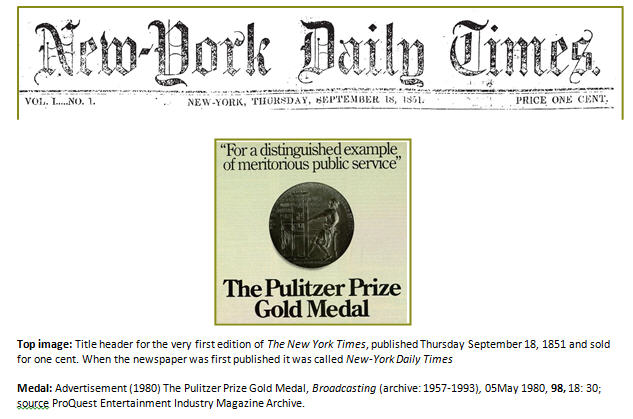
The Pulitzer Prize
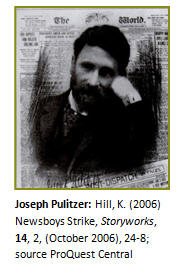
Joseph Pulitzer was the publisher responsible for introducing new journalistic techniques in the late 19th Century. In his day he was quite an influential character; he stood up against corruption in business, was elected to Congress in New York and was one of the wealthiest men in the country.
Upon his death he bequeathed money to establish a prize fund to be given out by Columbia University with the intention of continuing his fostering of great journalism. The prizes are still given annually for achievements in a variety of journalistic forms: reporting, photography, art, music, poetry, drama and many more.
Today there are 21 categories, and each winner also receives $10,000 cash. Hundreds of awards have been made since the ceremony first started in 1917, but no other body has won more awards that The New York Times, which has accrued 109 of them. While the newspaper itself won a Pulitzer in 1918, it wasn't until 1920 that the individual employees started racking up the prizes.
Ask for a free product trial today and see what you can discover.
1920s: Their very first winner was Alva Johnston
In 1922, the Pulitzer Prize for reporting went to Alva Johnston for his reporting of developments in science, via a conference in Massachusetts in 1922.
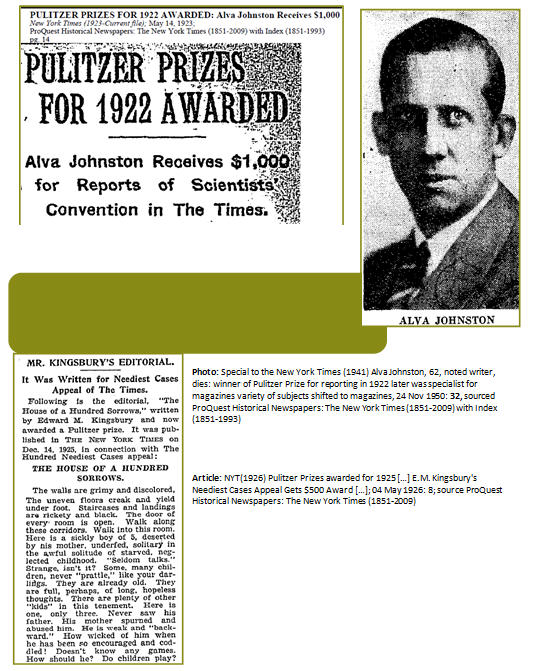
The New York Times' Pulitzer Prizes through the years:
1923: Alva Johnston, reporting of science news
1926: Edward M. Kingsbury, most distinguished editorial
1930: Russell Owen, graphic news
1932: Walter Duranty, reporting from Russia
1934: Frederick T. Birchall, reporting from Germany
1935: Arthur Krock, distinguished, impartial and analytical Washington coverage
1936: Lauren Dwight Lyman, reporting on the departure of the Lindberghs for England
1937: Anne O'Hare McCormick, foreign correspondence; William L. Laurence, reporting of the Tercentenary Celebration at Harvard, shared with four other reporters.
1938: Arthur Krock, Washington correspondence
1940: Otto D. Tolischus, overseas articles (economic and ideological background of war – engaged Germany)
1941: The New York Times, special citation for the public education value of its foreign news reports
1942: Louis Stark, reporting of labour stories
1943: Hanson W. Baldwin, series of articles reporting a tour of the Pacific battle areas
1944: The New York Times, most disinterested and meritorious service rendered by an American newspaper–a survey of the teaching of American history
1945: James B. Reston, articles on the Dumbarton Oaks Security Conference.
1946: Arnaldo Cortesi, correspondence from Buenos Aires; William L. Laurence, eyewitness account of the atomic bombing of Nagasaki and articles on the atomic bomb.
1947: Brooks Atkinson, series of articles on Russia
1949: C.P. Trussell, covering the national scene from Washington.
1950: Meyer Berger, local reporting–an article on the killing of 13 people by a berserk gunman
1951: Arthur Krock, exclusive interview with President Harry Truman; Cyrus L. Sulzberger, interview with Archbishop Stepinac of Yugoslavia
1952: Anthony H. Leviero, national reporting.
1953: The New York Times, special citation for its Review of the Week section
1955: Harrison E. Salisbury, series based on his five years in Russia; Arthur Krock, correspondence from Washington.
1956: Arthur Daley, sports column, "Sports of The Times."
1957: James B. Reston, reporting from Washington.
1958: The New York Times, coverage of foreign news.
1960: A.M. Rosenthal, reporting from Poland
1963: Anthony Lewis, reporting of the United States Supreme Court
1964: David Halberstam, reporting from South Vietnam
1968: J. Anthony Lukas, local reporting
1970: Ada Louise Huxtable, (Architecture)
1971: Harold C. Schonberg, music critic, for distinguished criticism.
1972: The New York Times, public service by a newspaper (Pentagon Papers).
1973: Max Frankel, international affairs (President Richard Nixon's visit to China)
1974: Hedrick Smith, foreign affairs (Soviet Union).
1976: Sydney H. Schanberg, foreign affairs (Cambodia); Walter (Red) Smith ("Sports of The Times")
1978: Henry Kamm, articles (Indochinese refugees); Walter Kerr, drama criticism; William Safire, columns on the Bert Lance affair
Click here to request a free trial today.
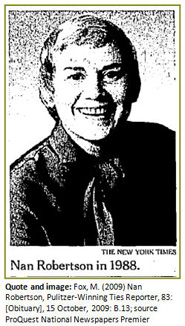
1980s: Nan Robertson
Nan Robertson worked for The New York Times for three decades and won the Pulitzer Prize in 1983 for her article "Toxic Shock", which described her own battle with the illness, a rare blood poisoning disease which resulted in the tips of all her fingers being amputated.
"I went dancing the night before in a black velvet Paris gown, on one of those evenings that was the glamour of New York epitomized. I was blissfully asleep at 3 a.m.
"Twenty-four hours later, I lay dying, my fingers and legs darkening with gangrene."
Amazingly, after rehabilitation, Ms. Robertson was able to write again. She also wrote about her battle with alcoholism and the suit filed against her own workplace, The New York Times, by 550 of its female workforce for inequalities such as pay, assignments and advancement.
List of Pulitzer Awards in the 1980s
1981: Dave Anderson, "Sports of The Times" column; John M. Crewdson, national affairs
1982: John Darnton, coverage of crisis in Poland; Jack Rosenthal, example of editorial page writing
1983: Thomas L. Friedman, coverage of the war in Lebanon; Nan C. Robertson, feature writing on her experience with toxic shock syndrome
1984: Paul Goldberger, architecture criticism; John Noble Wilford, reporting on scientific topics
1986: Donal Henahan, music criticisim; The New York Times, for explanatory journalism: series of articles on the Strategic Defense Initiative, the "Star Wars" program
1987: The New York Times, reporting on causes of the Challenger shuttle disaster; Alex S. Jones, reporting on the dissension that dissolved a Louisville newspaper dynasty
1988: Thomas L. Friedman, for coverage of Israel
1989: Bill Keller, for coverage of the Soviet Union
Robertson found herself concerned with a diverse mix of employment rights, medical issues and alcoholism, adjusting to disfigurement, therapy and ultimately (a testimony to her determination) winning an award.
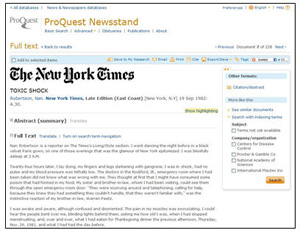
Using ProQuest Newsstand you can read Robertson's Pulitzer Prize-winning article in full and gain unparalleled insight into the work and lives of an award-winning journalist.
1990s: Nicholas Kristof and Sheryl WuDun
For the first time in its history, a Pulitzer Prize was awarded to a husband and wife team. Nicholas Kristof and Sheryl WuDunn of The New York Times were awarded the prize for their coverage of China’s suppression of pro-democracy protests in Beijing.
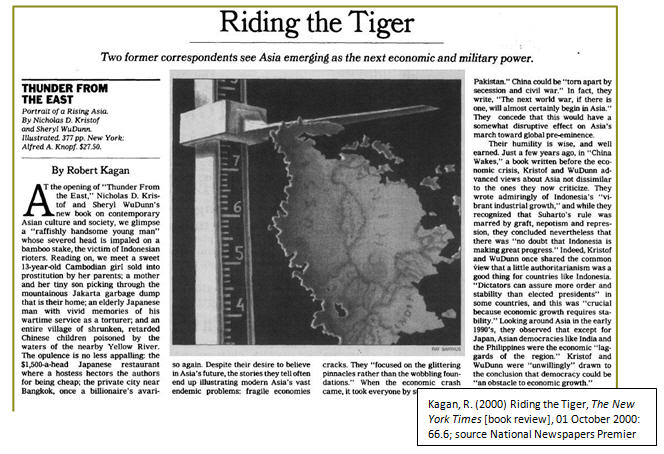
List of Pulitzer Awards in the 1990s
1990: Nicholas D. Kristof and Sheryl WuDunn, for coverage of political turmoil in China
1991: Natalie Angier, for coverage of molecular biology and animal behavior; Serge Schmemann, for coverage of the reunification of Germany
1992: Anna Quindlen, "Public & Private," column covering a wide range of personal and political topics; Howell Raines, for "Grady's Gift," (childhood friendship and interracial relationships).
1993: John F. Burns, for courageous coverage of the strife and destruction in Bosnia
1994: The New York Times, World Trade Center bombing; Isabel Wilkerson, feature writing; Kevin
Carter, photography (Sudan)
1995: Margo Jefferson, criticism
1996: Rick Bragg, (features); Robert McFadden, journalism; Robert Semple, editorial (environment)
1997: John F. Burns, reporting (Taliban movement in Afghanistan)
1998: Linda Greenhouse, (Supreme Court's work and significance); Michiko Kakutani, (literary reviews); The New York Times, series (drug corruption in Mexico)
1999: Maureen Dowd, columns on the combat between President Bill Clinton and Kenneth Starr; The New York Times, notably Jeff Gerth, series (corporate sale of American technology to China)
2000s: David Barstow and Lowell Bergman
List of Pulitzer Awards in the 2000s
2001: The New York Times, series (racial and contemporary America)
2002: The New York Times, daily special (terrorism); The New York Times, profiling terrorist networks; The New York Times, photographs (Afghanistan and Pakistan); The New York Times, photographic coverage (attack on New York); Gretchen Morgenson, Wall Street coverage; Barry Bearak, (daily life in Afghanistan); Thomas Friedman, worldwide impact terrorist threat
2003: Clifford J. Levy, "Broken Homes" series (abuse of mentally ill)
2004: The New York Times, series by David Barstow and Lowell Bergman (safety at work)
2005: Walt Bogdanich, investigative series (railway crossings accident controversies)
2006: Nicholas Kristof, commentary (Darfur); Joseph Kahn and Jim Yardley, reporting (China); James Risen and Eric Lichtblau, (United States' Government's secret eavesdropping program).
2007: Andrea Elliott, feature (immigrant imam)
2008: Amy Harmon (social impact of genetics); Walt Bogdanich and Jake Hooker (contaminated ingredients/medicine)
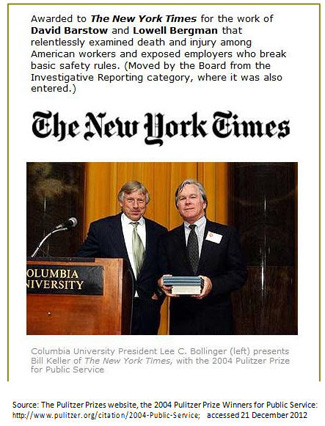
2010s: Eight so far... and counting
List of Pulitzer Awards in the 2010s
2010: Michael Moss (investigative feature); Matt Richtel for reporting; Sheri Fink (Hurricane Katrina)
2011: Clifford Levy and Ellen Barry (Journalist) for international reporting (Russia); David Leonhardt, for commentary (Economic)
2012: David Kocieniewski for explanatory journalism; Jeffrey Gettleman, reporting (East Africa).
What about other Pulitzer Prize winners?
With the significant back file coverage available in ProQuest Newsstand, researchers are able to accurately cross-search between newspaper titles to compare perspectives. There is also the capability to search current and historical newspaper files at the same time, leaving no angle uncovered.
Contact your local area sales rep today to arrange an instant free trial.
About ProQuest Newsstand
This database's detailed indexing helps users quickly find the news information they need. Each issue of each newspaper is indexed thoroughly, so researchers have access to not only top news stories but also the information contained on the various sections of the papers. The indexing covers not only complete bibliographic information but also companies, people, products, etc.
ProQuest Newsstand — What will you discover?
Ask for your FREE trial of this product now!